Just in time for Christmas, prepare to be amazed by the delightful qualities of my gluten-free and low-carb panettone. It boasts a superbly fluffy, light, and citrusy texture. This simple and easy-to-follow gluten-free panettone recipe ensures a healthy and delicious holiday treat that you can effortlessly recreate at home!
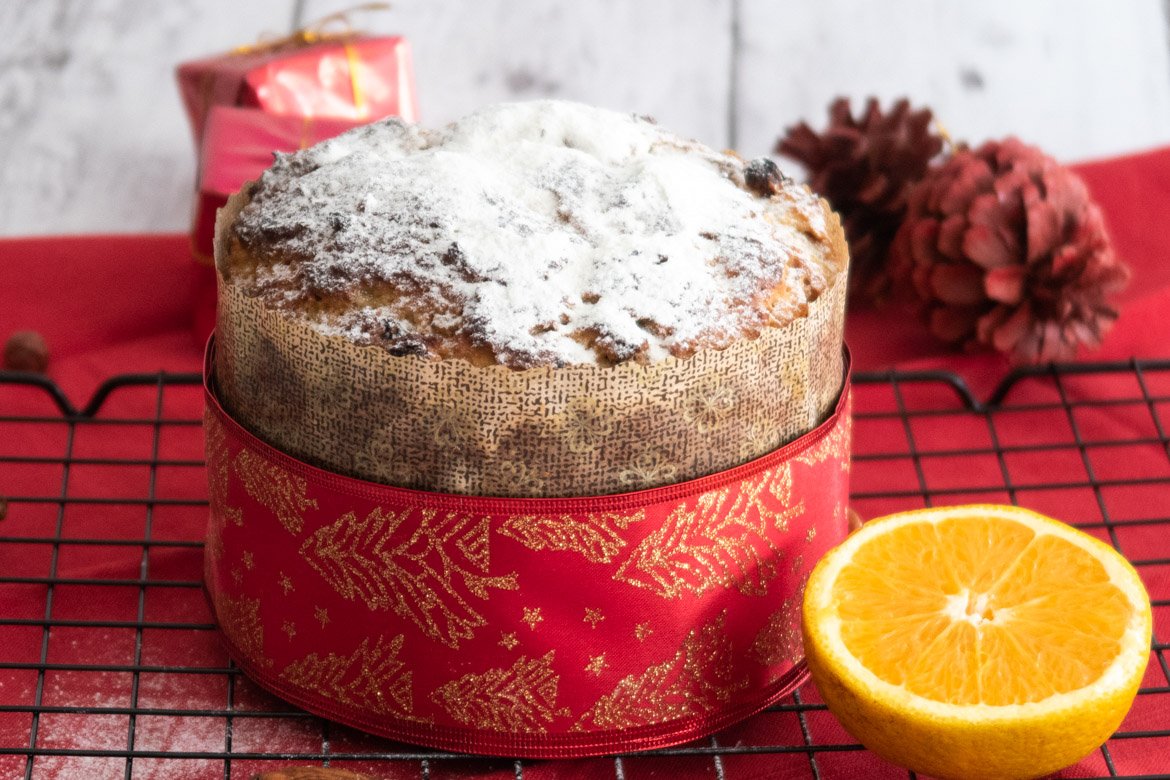
The holiday season is synonymous with indulging in delightful treats, and what better way to celebrate than with a gluten-free panettone bread that caters to both your festive spirit and your commitment to a healthier lifestyle?
Table of Contents
A FESTIVE DELIGHT FOR HEALTH-CONSCIOUS FOODIES
Panettone is a traditional dessert for end-of-year celebrations. However, the panettone sold in the market usually contains a high amount of sugar, chemical additives, and preservatives. That’s why I am suggesting a healthier version of this Christmas treat.
This gluten-free panettone is made with oat flour. While oats are a popular and widely used food, it’s important to remember that they are naturally gluten-free. However, contamination can occur during processing, so it’s essential to purchase certified gluten-free rolled oats or oat flour to ensure that the product is safe for consumption.
Another interesting fact about oats is that they contain a type of fiber called beta-glucan. When combined with a balanced diet low in fat, beta-glucan has been shown to effectively reduce cholesterol levels.
INGREDIENTS
Wet Ingredients:
- Orange Juice: Provides a citrusy zing, enhancing flavor.
- Brown Sugar: Help activate the yeast.
- Dry Yeast: Acts as a leavening agent for a light and fluffy texture.
- Free-Range Eggs: Contributes to the structure and moisture of the panettone.
- Coconut Oil or Ghee: Adds richness and moisture.
- Apple Cider Vinegar: Enhances the leavening process and provides a subtle tang.
- Orange Zest: Infuses a burst of citrus aroma and flavor.
Dry Ingredients:
- Oat Flour: Gluten-free alternative with a hearty texture.
- Potato Starch: Provides structure and a light crumb.
- Almond Flour: Imparts a nutty richness and moistness.
- Xylitol: A low-carb sweetener for guilt-free indulgence.
- Xanthan Gum: Enhances elasticity and structure in gluten-free baking.
- Dried Fruits: Offers sweetness and chewy texture.
- Walnuts: Introduces a delightful crunch and nutty flavor.
INSTRUCTIONS
Preparing homemade gluten-free panettone is simple, but requires several steps:
1. Activate the Yeast:
- Combine 150 ml of natural orange juice, brown sugar, and dry yeast. Let it sit for 5-15 minutes until frothy in a warm place.


2. Prepare the Wet Mixture:
- In a blender or in a bowl, whisk together the eggs, coconut oil, apple cider vinegar, and orange zest.


3. Combine Dry Ingredients:
- In a separate bowl, mix oat flour, potato starch, almond flour, xylitol powder, and xanthan gum.


4. Incorporate the yeast:
- Mix the liquid ingredients with the yeast.


5. Create the Panettone Batter:
- Gradually add the dry mixture to the wet mixture, stirring carefully with your fingertips until well combined.
When using different brands or batches of flour, it’s important to observe how the panettone batter absorbs hydration, which can be also influenced by the humidity in the air.
When making gluten-free panettone, it’s important to ensure that the batter has the right consistency. It should be fluid, not too thick or too runny, and should easily take the shape of the panettone without much effort.
To achieve this, you need to add the remaining orange juice gradually and keep an eye on the batter’s hydration. If necessary, you can add a little more juice. Without proper hydration, the yeast won’t activate the batter, and it won’t rise. This will result in a heavy and hard panettone that lacks the desired lightness and softness.
6. Incorporate Dried Fruits and Nuts:
- Dust the fruits and chopped walnuts with a tablespoon of reserved potato starch. This step ensures that, when added to the batter, the fruits won’t sink to the bottom.
- Fold them in panettone batter.
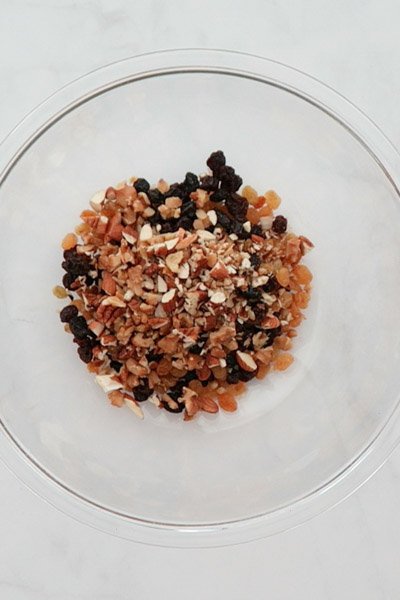
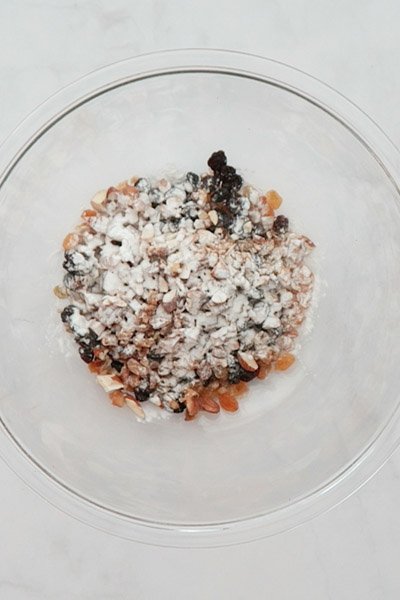


7. Rise and Shine:
- Transfer the panettone batter evenly inside a 500 ml panettone mold, filling it up to 3/4 of the mold’s capacity. In case you don’t have a panettone mold, you can use a greased 8-inch round pan instead. However, keep in mind that the panettone will be wider than taller.
- Allow the batter to rise in a warm place for 1-2 hours or until doubled in size.

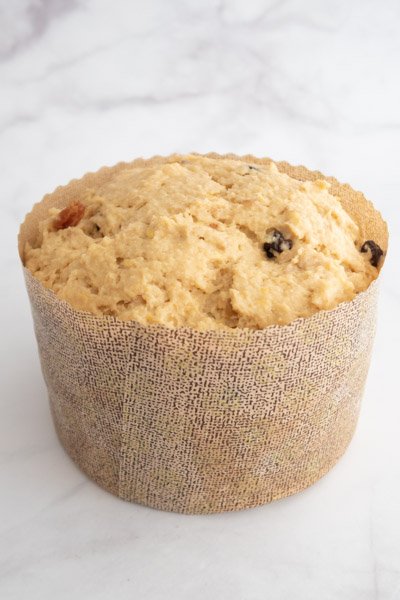
9. Bake to Perfection:
- Bake the gluten-free panettone in a preheated oven at 180ºC/350ºF for around 35-40 minutes or until it turns golden brown. You can check if it’s done by doing the toothpick test or by checking the internal temperature, which should read 88-90ºC/190-194ºF. If the panettone starts to brown too quickly, cover it with aluminum foil and continue baking.
10. Savor the Moment:
- Let the panettone cool before slicing. Serve and relish in the guilt-free joy of a gluten-free and low-carb holiday treat!
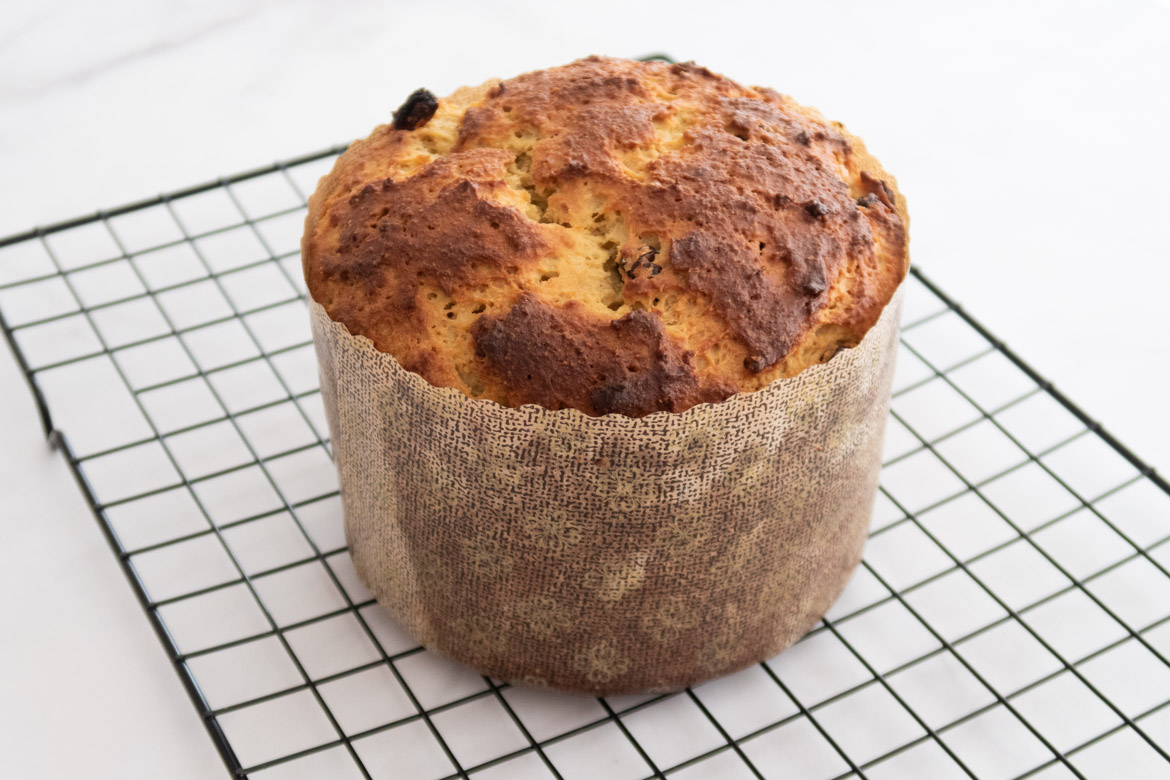
DO I NEED TO HANG THE HOMEMADE PANETTONE UPSIDE DOWN
Once the panettone is baked, it is typically pierced with a skewer and hung upside down. This is done to prevent it from collapsing in on itself. However, in the case of gluten-free panettone, I have discovered that this step is unnecessary. Simply remove the gluten-free panettone from the oven and place it on a wire rack to cool completely. It is worth noting that some recipes are actually easier to make gluten-free!
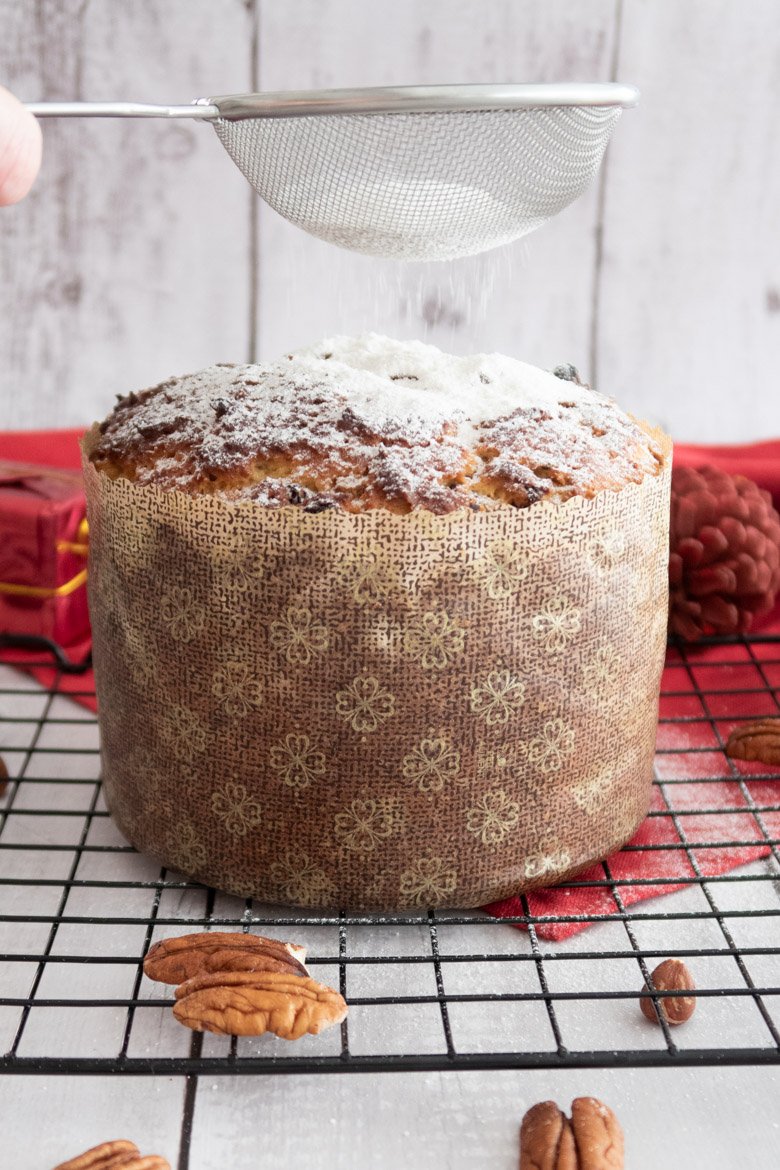
TIPS FOR THE GLUTEN-FREE PANETTONE RECIPE
- Remember, for this recipe to be safe for people with celiac disease, all ingredients must be gluten-free! Ensure that you purchase gluten-free oat flour. While oats are naturally gluten-free grains, in many cases, they may be processed alongside other grains, such as wheat, leading to potential contamination. Therefore, it cannot be considered gluten-free.
- It is crucial to spread the panettone dough evenly, especially on the bottom of the mold, to prevent air bubbles and gluten-free panettone collapse during baking. Remember to fill the molds only halfway or three-quarters full.
- It is always recommended to weigh your ingredients when baking gluten-free recipes. This will not only reduce the number of dishes you need to wash but also ensure consistent results every time. Keep in mind that gluten-free and keto baking is highly sensitive, and measuring by cups is less accurate. If you don’t have a baking scale, use measuring cups, but make sure to drop the ingredients into them instead of scooping them out, as this often leads to overweighing.
- It’s important to use ingredients at room temperature, especially for eggs. Adding cold eggs to the dough can prevent the panettone from rising properly.
- To activate the yeast, you need to mix dry yeast with warm orange juice. The juice should be hot to the touch, between 40-43°C. Add sugar to the mixture and let it sit for 15 minutes until it foams and makes a sponge. Don’t worry about the sugar, as yeast feeds on it to emit carbon dioxide, which doesn’t affect the carb count. This is a scientific fact.
- Avoid exposing the panettone to sudden temperature changes or drafts. Allow it to rest undisturbed in a warm, draft-free space. I usually leave it in the oven, turned off.

GLUTEN-FREE PANETTONE STORAGE
Ensuring proper storage for your gluten-free panettone is crucial for maintaining its freshness and flavor. Here’s a guide on how to store your gluten-free panettone:
Counter Storage:
- Duration: Up to 2 Days
- Method: Wrap the panettone properly to prevent exposure to air. While it can be kept on the counter for a short duration, be aware that it may start to stale after 2 days.
Toasting Option:
- Tip: If your panettone becomes slightly stale, transform it into a delightful treat by toasting it! Use a buttered frying pan for a delicious twist.
Freezer Storage:
- Duration: Up to 2-3 Months
- Method:
- Slice it: Divide the panettone into individual slices for convenient usage.
- Wrap each slice: Ensure each slice is wrapped tightly in plastic wrap to prevent freezer burn.
- Ziploc Freezer Bag: Place the wrapped slices in a Ziploc freezer bag for added protection.
- Label and Date: For easy identification, label the bag with the content and date of freezing.
- Freezer Placement: Store the bag in the freezer, ensuring it is placed away from items that might impart unwanted odors.
Thawing and Enjoying:
- Method: When ready to enjoy, remove the desired number of slices from the freezer and let them thaw at room temperature for a short time. Optionally, you can warm them up in a toaster or oven for a fresh-from-the-oven experience.
By following these storage tips, you can savor the gluten-free panettone’s delectable taste for an extended period. Whether enjoyed fresh, toasted, or after freezing, your gluten-free panettone can continue to be a delightful treat throughout the holiday season and beyond.
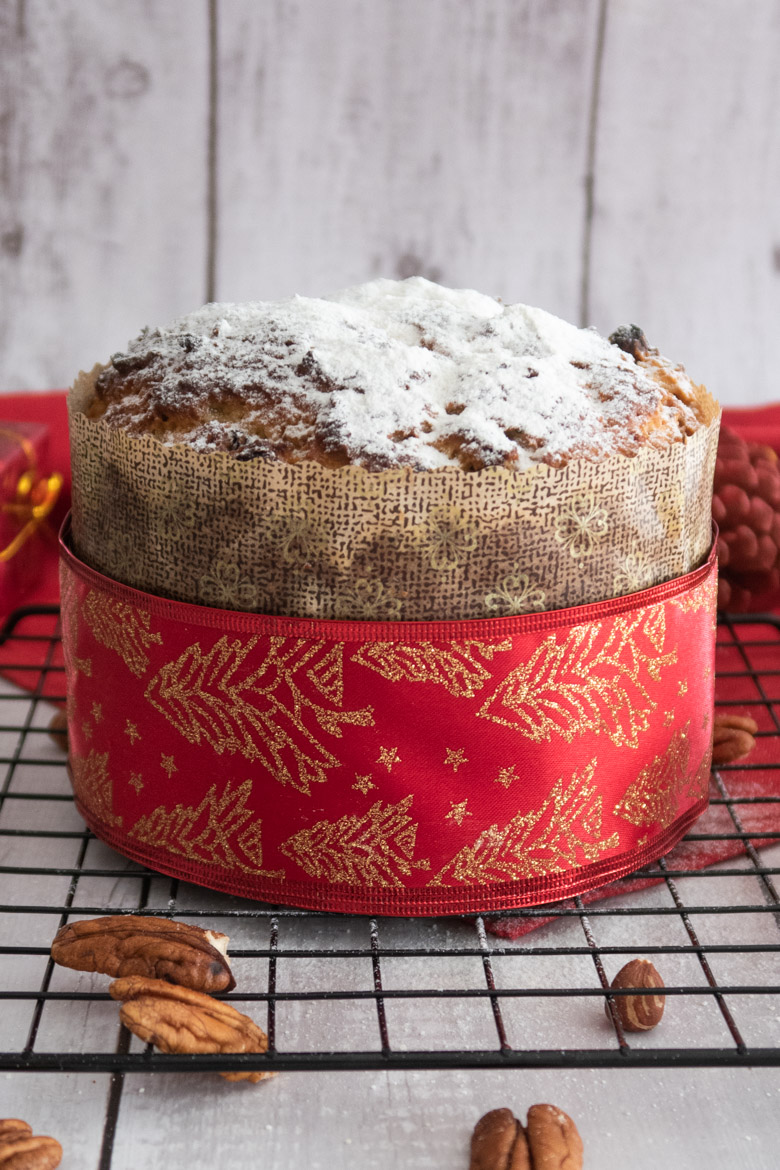
This gluten-free and low-carb panettone is a testament to the fact that you can celebrate the holidays without compromising your commitment to a healthier lifestyle. Enjoy the festive season with this delectable treat that brings together the joy of baking and the essence of well-being!

Gluten-Free Homemade Panettone
Equipment
- Large bowl
- 3 Medium bowls
- Blender
- Spatula
- Panettone mold (500 ml)
Ingredients
- 150 ml + 60 ml natural orange juice
- 20 g (2 tbsps) brown sugar
- 150 g (1 cup) dried fruits
- 50 g (½ cup chopped walnuts
- 10 g (1 tbsp) dry yeast
- 3 eggs, free-range
- 30 ml (2 tbsps) coconut oil or ghee
- 15 ml (1 tbsp) apple cider vinegar
- 1 orange, zest only
- 100 g (1 cup) oat flour
- 120 g (¾ cup) potato starch, reserve 1 tbsp. for the dried fruit and nuts
- 130 g (1 cup) almond flour
- 50 g xylitol powder
- 3 g (1 tsp) xanthan gum
Instructions
- Combine 150 ml of natural orange juice, brown sugar, and dry yeast. Let it sit for 5-15 minutes until frothy in a warm place.
- In a bowl, whisk together the eggs, coconut oil, apple cider vinegar, and orange zest.
- In a separate bowl, mix oat flour, potato starch, almond flour, pulverized xylitol, and xanthan gum.
- Mix the liquid ingredients with the yeast.
- Gradually add the wet mixture to the dry mixture, stirring carefully with your fingertips until well combined. Add the remaining orange juice little by little and monitor the hydration of the batter. If necessary, add a little more juice.(When using different brands or batches of flour, it's important to observe how the panettone batter absorbs hydration, which can be also influenced by the humidity in the air.When making gluten-free panettone, it's important to ensure that the batter has the right consistency. It should be fluid, not too thick or too runny, and should easily take the shape of the panettone without much effort.To achieve this, you need to add the remaining orange juice gradually and keep an eye on the batter's hydration. If necessary, you can add a little more juice. Without proper hydration, the yeast won't activate the batter, and it won't rise. This will result in a heavy and hard panettone that lacks the desired lightness and softness.)
- Dust the fruits and chopped walnuts with a tablespoon of reserved potato starch to prevent sinking during baking. Fold them in panettone batter.
- Transfer the panettone batter evenly inside a 500 ml panettone mold, filling it up to 3/4 of the mold's capacity. (In case you don't have a panettone mold, you can use a greased 8-inch round pan instead. However, keep in mind that the panettone will be wider than taller.)
- Allow the batter to rise in a warm place for 1-2 hours or until doubled in size.
- Bake the gluten-free panettone in a preheated oven at 180ºC/350ºF for around 35-40 minutes or until it turns golden brown. You can check if it's done by doing the toothpick test or by checking the internal temperature, which should read 88-90ºC/190-194°F. If the panettone starts to brown too quickly, cover it with aluminum foil and continue baking.
- Let the panettone cool before slicing. Serve and relish in the guilt-free joy of a gluten-free and low-carb holiday treat!
